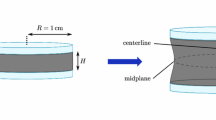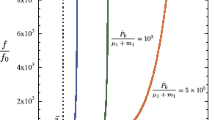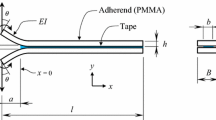Abstract
A fracture mechanics analysis is performed to get a criterion for irreversible growth of cavities in rubber-like materials. The limit of reversible growth of a hole is calculated using the Griffith fracture criterion for a hyperelastic incompressible material (neo-Hookean behavior law) submitted to a hydrostatic tension under the assumptions of large deformations. It leads to an expression of the energy released rate G for the crack-like hole. This expression is shown to be different from results obtained by other authors. The reversible deformation of the cavity under finite triaxiality is also examined by considering a particular field of kinematically admissible displacements. The so obtained approached solution is used to extend the expression of the energy released rate G to various triaxial tension loadings.
Similar content being viewed by others
REFERENCES
Ball, J.M. (1982). Discontinuous equilibrium solutions and cavitation in nonlinear elasticity. Philosophical Transactions of the Royal Society of London A306, 557–610.
Diani, J. (1999). Contribution au comportement élastique et à l'endommagement des matériaux élastiaux élastomères. Thèse de Doctorat de l'Ecole Normale Súperieure de cachan.
Fond, C., Lobbrecht, A. and Schirrer, R. (1996). Polymers toughed with rubber microspheres: an analytical solution for stresses and strains in the rubber particles at equilibrium and rupture. International Journal of Fracture 77, 141–159.
Gent, A.N. and Lindley, P.B. (1959). Internal rupture of bonded rubber cylinders in tension. Proceedings of the Royal Society A2, 195–205.
Gent, A.N. and Tompkins, D.A. (1969). Nucleation and growth of gas bubbles in elastomers. Journal of Applied Physics 40, 2520–2525.
Gent, A.N. and Wang, C. (1991). Fracture mechanics and cavitation in rubber-like solids. Journal of Materials Science 26, o3392–3395.
Green, A.E. and Zerna, W. (1992). Theoretical Elasticity. University Press, Oxford.
Griffith, H.S. (1921). The phenomena of rupture and flow in solids. Philosophical Transactions of the Royal Society, London A221, 163.
Hou, H.S. and Aberyaratne, R. (1992). Cavitation in elastic and elastic-plastic solids. Journal of the Mechanics and Physics of Solids 40, 571–592.
Quigley, C.J. and Parks, D.M. (1994). The finite deformation field surrounding a mode I plane strain crack in a hyperelastic incompressible material under small-scale nonlinearity. International Journal of Fracture 65, 75–96.
Williams, M.L. and Schapery, R.A. (1968). Spherical flaw instability in hydrostatic tension. International Journal of Fracture Mechanics 1, 64–71.
Author information
Authors and Affiliations
Rights and permissions
About this article
Cite this article
Diani, J. Irreversible growth of a spherical cavity in rubber-like material: A fracture mechanics description. International Journal of Fracture 112, 151–161 (2001). https://doi.org/10.1023/A:1013311526076
Issue Date:
DOI: https://doi.org/10.1023/A:1013311526076




